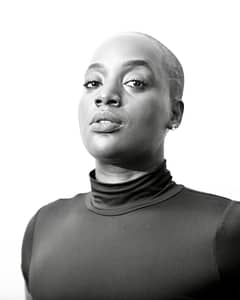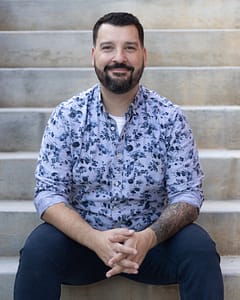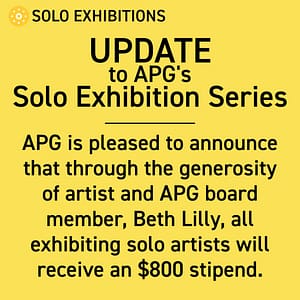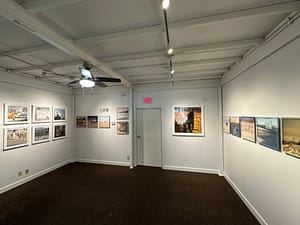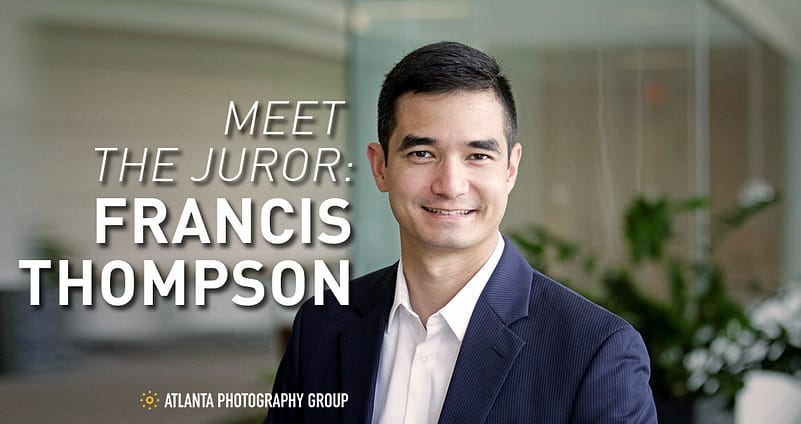
Meet Francis Thompson – APG’s Donna Garcia took some time with Francis learning about his role as art program manager for a contemporary corporate art collection.
Francis is the juror for the upcoming exhibition Francis Thompson SELECTS.
Why did you decide to become an art curator / collector?
My exposure to exhibition and curation began while I was a master’s student in Arts Administration at Virginia Polytechnic & State University, where some responsibilities included assisting the coordination of the exhibitions in the university gallery. My master professor, Ray Kass, is the founder and director of the Mountain Lake Workshops who invited artists to collaboratively create works of art with the students and local community. Several of the exhibitions I helped coordinate featured artwork from these workshops that included works by artists such as Merce Cunningham, Jackie Matisse, Jiro Okura, John Cage, and several others. The workshop with Jackie Matisse developed into my research project which was the most informative and impactful experience that I had during my time as a student. We developed a collaboration between Jackie Matisse and the virtual reality ‘CAVE’ team at VA Tech along with a partnership with the University of Illinois at Urbana-Champaign to reconstruct the artist’s artwork into virtual reality. The granddaughter of Henri Matisse and the stepdaughter of Marcel Duchamp, Jackie Matisse makes kites that are launched into the air or submerged underwater. The collaboration pointed me in working with Jackie directly for coordinating a kite making workshop and an exhibition of the virtual reality piece along with several of her kites. I traveled to her studio in France to select the works and later develop the exhibition design for the installation process. It was this experience that refined my interest in seeking a profession in art curation and collection management.
What is unique about the curating and development of the current collections and exhibitions?
What I’ve always found unique about the collection is the focus  on emerging artists. Often, we reach out to university undergraduates and masters studio art students for consideration into the collection. In doing so we have found to have a strong positive impact on those student artists. There is also inclusion of mid-career and established artists but cultivating works from the community by artists seeking to advance their artistic career allows latitude to widen the collection content. Showcasing works by well-known artists from the community is an important element of being current with trends and reflecting current culture. But emerging artists, especially those developing their work through academia, give reach to new perspectives, techniques and artistic voices. The collection also focuses on representing the city, state or region of where the artwork is installed. We put much of our effort into purchasing work locally and as such the collection reflects the employee community. Corporate collections can vary greatly in collecting strategies. I’ve seen a fair number of corporate art collections and they all are unique in their approach. My personal philosophy on corporate collections to be effective is that it must facilitate an interaction and dialogue with your employee audience. Bandwidth for employees to interact with the collection can vary greatly – from a few glances on the way to a meeting or a casual 5-minute stop to examine thoroughly the piece and read the artwork label. What interests everyone of a large corporate workforce can vary greatly as well. Therefore, I think that thoughtfully constructing a collection that has harmony with its physical environment and content that is accessible to the viewing audience can accomplish that. The focused strategy we have taken is to be reflective of the immediate community and expand ideas through new ideas led by emerging artists.
on emerging artists. Often, we reach out to university undergraduates and masters studio art students for consideration into the collection. In doing so we have found to have a strong positive impact on those student artists. There is also inclusion of mid-career and established artists but cultivating works from the community by artists seeking to advance their artistic career allows latitude to widen the collection content. Showcasing works by well-known artists from the community is an important element of being current with trends and reflecting current culture. But emerging artists, especially those developing their work through academia, give reach to new perspectives, techniques and artistic voices. The collection also focuses on representing the city, state or region of where the artwork is installed. We put much of our effort into purchasing work locally and as such the collection reflects the employee community. Corporate collections can vary greatly in collecting strategies. I’ve seen a fair number of corporate art collections and they all are unique in their approach. My personal philosophy on corporate collections to be effective is that it must facilitate an interaction and dialogue with your employee audience. Bandwidth for employees to interact with the collection can vary greatly – from a few glances on the way to a meeting or a casual 5-minute stop to examine thoroughly the piece and read the artwork label. What interests everyone of a large corporate workforce can vary greatly as well. Therefore, I think that thoughtfully constructing a collection that has harmony with its physical environment and content that is accessible to the viewing audience can accomplish that. The focused strategy we have taken is to be reflective of the immediate community and expand ideas through new ideas led by emerging artists.
Which new art making and buying trends are you following?
Recently, the collection has begun significant inclusion of murals. Many buildings are in cities that have thriving public art and/or mural projects championed by local artists or public art programs. That broad public interest in mural art has spilled over into the employee population. Therefore, indoor and outdoor commissioned projects have entered the collection. Commissioned mural art provides leverage in collaboration with the artist to define the content to its immediate environment and themes derivative from the geographical landscape or cityscape.
How do you find new artists for the collections and exhibitions?
 For the collection, there are a variety of approaches which can be dependent on the needs of the project at hand. Earlier mentioned murals can be based on a request for proposal related process or specific artists that are of interest to the collection. Staying current with activity in the art communities the buildings are located is an important channel in finding out about new artists as well. Since the collection occupies buildings in multiple cities, it isn’t physically possible to have an eye on activity on all locations at the same time. We will also work with art consultants that have strong connections with the artists and community to assist. I feel it becomes a balance of what the needs are of a collecting endeavor at the time of acquisition and selecting the best resource on hand to be as accurate as possible.
For the collection, there are a variety of approaches which can be dependent on the needs of the project at hand. Earlier mentioned murals can be based on a request for proposal related process or specific artists that are of interest to the collection. Staying current with activity in the art communities the buildings are located is an important channel in finding out about new artists as well. Since the collection occupies buildings in multiple cities, it isn’t physically possible to have an eye on activity on all locations at the same time. We will also work with art consultants that have strong connections with the artists and community to assist. I feel it becomes a balance of what the needs are of a collecting endeavor at the time of acquisition and selecting the best resource on hand to be as accurate as possible.
For exhibitions, the above also applies but there is more weight in being actively involved and aware of what is happening in the art community. Personally, I keep very active through volunteer work, attending events, and participating in the art community – even the locations that are outside of the city I reside in. Exhibitions are a more involved process and expand further than only showcasing art objects to programming such as artist talks, receptions, workshops, and more. There is close collaboration with arts organizations in the communities and in that partnership, it facilitates discovery of new artist’s as well.
The international art fairs that take place throughout the year have provided a lot of resources in learning about artists or works. Last Fall, I attended two panel discussions at Expo Chicago that included photographer Dawoud Bey. The panel talks and his exhibition at one of the gallery booths of Night Coming Tenderly, Black series greatly impacted me. The imagery was rich and evocative. Seeing the depicted landscape of the underground railroad and thinking how someone would traverse it at night inspired me to revisit studying that time of history. On a personal level, this work has had lasting interest.
Describe the corporate collections in five words?
_____Innovative
_____Inspirational
_____Reflective
_____Purposeful
_____Diverse
How important is it for you to meet the artist behind the artwork?
Meeting the artist behind the work allows deeper knowledge of the artwork or body of work by the artist. Providing access to more information on the artwork to the viewer is important to us. As is the process of selecting the works to ensure it aligns with the purpose it will have in the collection. Reading material about the artist is usually enough, but if the work is in a significant location or merits a deeper dive to learn more to share later, then meeting the artist can have importance. This can hold very true with commissioned works of art. I personally find the opportunity to meet with the artist enriching and are the moments that I enjoy the most. Studio visits can be invaluable regarding the process and what the narrative is behind the work.
Do you look for work that creates a cohesive narrative for the viewer or something more abstract?
It is a mix of both types of works. Since the viewing audience represents a wide range of interests in art, it is an important balance between narrative based or abstract works. Over the years, it has been interesting to occasionally receive the feedback from the viewing audience noting they wish for more of one of these two. Most of the time this is since there isn’t a good balance between these two types in their immediate work area. Or simply because they prefer one over the other. It is not possible to reach everyone’s personal interest in art, so I think the harmony is to try and provide a fair amount of representation from both general types.
Is there any particular type of art that always appeals to you or anything that unites all the works in the collection?
The color scheme used for the interiors has mostly been subtle colors  schemes. The art collection brings color and movement which helps to construct the overall characteristic of the workspace. This impacts which pieces enter the collection but is not the absolute deciding factor. The earlier mentioned strategy of the collection relates to the answer here, but I’d also like to add that the experience for the viewer is an important element as well. We consider which wall locations that experience heavy foot traffic all the way to which locations are more quiet private work areas. As the employee moves through the different areas of the workspace, the artwork should flow well along with having some commonality from one floor to another in the same building. For example, the artwork in the elevator lobbies may contain bold colors and ambitious movement within the work. Then the smaller conference rooms might have works that are more contemplative inviting the viewer to study the detail with a closer look. Over time, an employee will have viewed the works many times daily. Therefore, considering thoughtful placement to reach a strong experience according to the business use of the space is the important common thread.
schemes. The art collection brings color and movement which helps to construct the overall characteristic of the workspace. This impacts which pieces enter the collection but is not the absolute deciding factor. The earlier mentioned strategy of the collection relates to the answer here, but I’d also like to add that the experience for the viewer is an important element as well. We consider which wall locations that experience heavy foot traffic all the way to which locations are more quiet private work areas. As the employee moves through the different areas of the workspace, the artwork should flow well along with having some commonality from one floor to another in the same building. For example, the artwork in the elevator lobbies may contain bold colors and ambitious movement within the work. Then the smaller conference rooms might have works that are more contemplative inviting the viewer to study the detail with a closer look. Over time, an employee will have viewed the works many times daily. Therefore, considering thoughtful placement to reach a strong experience according to the business use of the space is the important common thread.
What are the wishes for the future of the collection? How would you like to see it progress?
Over the time I have been supporting my client’s collection for 16+ years, we have developed strong and effective procedures for building and managing the corporate art collection. One priority in our loaned exhibition programming has been collaborating with our community arts organizations partners to celebrate the cultural heritage and diversity months. We’ve crossed this over into the collection and hope this continues in its development. The same is true with digital art. We have explored this with our exhibition programming with a very positive response from the employees, but there is opportunity for digital based media to also enter the collection as well.
What is the best advice you have given or been given in terms of art collecting?
 Early in my career with the collection we developed a lectures series. One of our guest speakers was a curator in Richmond, Virginia, Jay Barrows, who shared with me the advice that the best practice for collecting art comes from the heart. If you acquire a piece of art that truly impacts you, it will never be a decision that you regret. I follow that philosophy with my own personal collection but restrain my personal interests in art for the collection I manage. This allows the mission of the collection to stand true and works that are selected to be the benefit of the employees and client. However, Mr. Barrows’ advice remains very valid in that thoughtful decision making for the collection of works that will have a lasting positive impact on the audience is well worth the challenge to achieve.
Early in my career with the collection we developed a lectures series. One of our guest speakers was a curator in Richmond, Virginia, Jay Barrows, who shared with me the advice that the best practice for collecting art comes from the heart. If you acquire a piece of art that truly impacts you, it will never be a decision that you regret. I follow that philosophy with my own personal collection but restrain my personal interests in art for the collection I manage. This allows the mission of the collection to stand true and works that are selected to be the benefit of the employees and client. However, Mr. Barrows’ advice remains very valid in that thoughtful decision making for the collection of works that will have a lasting positive impact on the audience is well worth the challenge to achieve.
Francis Thompson is the juror for the Atlanta Photograph Group’s upcoming exhibition – Francis Thompson SELECTS. This exhibition is an annual feature during Atlanta Celebrates Photography’s fall festival.
Exhibition: Oct 17 – Nov 28
Virtual opening & Juror talk: registration will be available on the website.
Call for Entry – Francis Thompson SELECTS
Regular Deadline: August 23
Final Deadline: August 30
Francis Thompson – Bio
Francis Thompson is the Art Program Project Manager at JLL. Over the past decade, he has managed a team responsible for maintaining and expanding a contemporary corporate art collection installed within office buildings throughout North America. During the early part of his role with the collection, he led the curatorial development of its rotating exhibition program which has grown to between seventy and eighty shows a year. On display within the corporate offices, these exhibitions brought in artwork from non-profit art organizations, local museums, university art departments, and corporate employees.
Francis has worked as Assistant Gallery Director for the Ellipse Art Center in Arlington, VA, assistant coordinator for the Mountain Lake Workshops with director/producer Ray Kass, and as Gallery Coordinator for the Virginia Tech Armory Gallery. A native of Virginia, he holds a Master of Fine Arts in Arts Administration and a Bachelor of Arts in Studio Art with a concentration in painting and drawing from Virginia Polytechnic Institute and State University in Blacksburg, VA.

